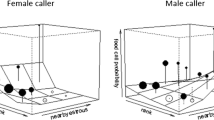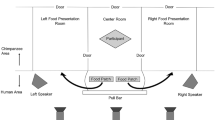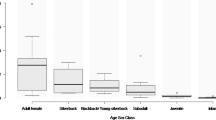Abstract
Chimpanzees produce acoustically distinct calls when encountering food. Previous research on a number of species has indicated that food-associated calls are relatively widespread in animal communication, and the production of these calls can be influenced by both ecological and social factors. Here, we investigate the factors influencing the production of food-associated calls in wild chimpanzees and examine whether male chimpanzees produce food-associated calls selectively in the presence of important social partners. Male chimpanzees form stable long-term social relationships with each other, and these social bonds are vital in enabling a range of cooperative activities, such as group hunting and territory defence. Our data show that males were significantly more likely to produce food-associated calls if an important social partner was nearby, regardless of the size of the audience or the presence of oestrus females. Call production was also mediated by the size of the food patch and by whether or not the food could be monopolised. The presence of important social partners explained most of the variation in male calling behaviour, indicating that food-associated calls are socially directed and serve a bonding function.

Similar content being viewed by others
References
Bates L (2005) Cognitive aspects of food location by the chimpanzees (Pan troglodytes schweinfurthii) of Budongo Forest Reserve, Uganda. Ph.D thesis: University of St Andrews
Bates D (2007) The LME4 package: linear mixed-effects models using S4 classes. R: Online
Benz JJ, Leger DW, French JA (1992) Relation between food preference and food-elicited vocalizations in golden lion tamarins (Leontopithecus-Rosalia). J Comp Psychol 106:142–149
Bugnyar T, Kijne M, Kotrschal K (2001) Food calling in ravens: are “yells” referential signals? Anim Behav 61:949–958
Caine NG, Addington RL, Windfelder TL (1995) Factors affecting the rates of food calls given by red-bellied tamarins. Anim Behav 50:53–60
Cheney DL, Seyfarth RM (1985) Vervet monkey alarm calls—manipulation through shared information. Behaviour 94:150–166
Crawley MJ (2002) Statistical computing: an introduction to data analysis using S-Plus. Wiley, Chichester
Dahlin CR, Balda RP, Slobodchikoff C (2005) Food, audience and sex effects on pinyon jay (Gymnorhinus cyanocephalus) communication. Behav Process 68:25–39
de Waal F (1982) Chimpanzee politics. Harper & Row, New York
de Waal F (1997) The chimpanzee's service economy: food for grooming. Evol Hum Behav 18:375–386
Di Bitetti MS (2005) Food-associated calls and audience effects in tufted capuchin monkeys, Cebus apella nigritus. Anim Behav 69:911–919
Dunbar R (1996) Grooming, gossip and the evolution of language. Faber and Faber, London
Dunford C (1977) Kin selection for ground squirrel alarm calls. Am Nat 111:782–785
Elgar MA (1986) House sparrows establish foraging flocks by giving chirrup calls if resources are divisible. Anim Behav 34:169–174
Elowson AM, Tannenbaum PL, Snowdon CT (1991) Food associated calls correlate with food preferences in cotton-top tamarins. Anim Behav 42:931–937
Evans CS, Marler P (1994) Food calling and audience effects in male chickens, (Gallus gallus)—their relationships to food availability, courtship and social facilitation. Anim Behav 47:1159–1170
Fedurek P, Dunbar RIM (2009) What does mutual grooming tell us about why chimpanzees groom? Ethology 115:566–575
Gilby IC (2006) Meat sharing among the Gombe chimpanzees: harassment and reciprocal exchange. Anim Behav 71:953–963
Gomes CM, Boesch C (2009) Wild chimpanzees exchange meat for sex on a long-term basis. PLoS ONE 4:e5116
Goodall J (1986) The chimpanzees of Gombe: patterns of behavior. Harvard University Press, Cambridge
Gros-Louis J (2003) The function of food-associated calls in white-faced capuchin monkeys, Cebus capucinus, from the perspective of the signaller. Anim Behav 140:565–592
Gyger M, Karakashian S, Marler P (1986) Avian alarm calling: is there an audience effect? Anim Behav 34:1570–1572
Hauser MD, Wrangham RW (1987) Manipulation of food calls in captive chimpanzees: a preliminary report. Folia Primatol 48:24–35
Hauser MD, Teixidor P, Field L, Flaherty R (1993) Food-elicited calls in chimpanzees: effects of food quantity and divisibility? Anim Behav 45:817–819
Hemelrijk CK, Anneke EK (1991) Reciprocity and interchange of grooming and ‘support’ in captive chimpanzees. Animal Behaviour 41:923–935
Houle A, Chapman CA, Vickery WL (2007) Intratree variation in fruit production and implications for primate foraging. Int J Primatol 28:1197–1217
Janik VM (2000) Food-related bray calls in wild bottlenose dolphins (Tursiops truncatus). Proc R Soc Lond B Biol Sci 267:923–927
Langergraber KE, Mitani JC, Vigilant L (2007) The limited impact of kinship on cooperation in wild chimpanzees. Proc Natl Acad Sci USA 104:7786–7790
Mahurin EJ, Freeberg TM (2009) Chick-a-dee call variation in Carolina chickadees and recruiting flockmates to food. Behav Ecol 20(1):111–116
Marler P, Tenaza R (1977) Signaling behavior of apes with special reference to vocalizations. In: Sebeok TA (ed) How animals communicate. Indiana Univ. Press, Bloomington, pp 965–1033
Marler P, Dufty A, Pickert R (1986) Vocal communication in the domestic chicken: II. Is a sender sensitive to the presence and nature of a receiver? Anim Behav 34:194–198
Mitani JC (2009) Male chimpanzees form enduring and equitable social bonds. Anim Behav 77:633–640
Mitani JC, Watts DP (2001) Why do chimpanzees hunt and share meat? Anim Behav 61:915–924
Mitani JC, Merriwether DA, Zhang C (2000) Male affiliation, cooperation and kinship in wild chimpanzees. Anim Behav 59:885–893
Mundry R, Fischer J (1998) Use of statistical programs for nonparametric tests of small samples often leads to incorrect p values: examples from animal behaviour. Anim Behav 56:256–259
Newton-Fisher NE (1999) The diet of chimpanzees in the Budongo Forest Reserve, Uganda. Afr J Ecol 37:344–354
Newton-Fisher NE (2004) Hierarchy and status in Budongo chimpanzees. Primates 45:81–87
Notman H, Rendall D (2005) Contextual variation in chimpanzee pant hoots and its implications for referential communication. Anim Behav 70:177–190
Pollick AS, Gouzoules H, De Waal FBM (2005) Audience effects on food calls in captive brown capuchin monkeys, Cebus apella. Anim Behav 70:1273–1281
Reynolds V (2005) The chimpanzees of Budongo forest: ecology, behaviour and conservation. Oxford University Press, Oxford
Reynolds V, Lloyd AW, Babweteera F, English CJ (2009) Decaying Raphia farinifera palm trees provide a source of sodium for wild chimpanzees in the Budongo Forest, Uganda. PLoS ONE 4(7):e6194
Ridley AR, Child MF, Bell MBV (2007) Interspecific audience effects on the alarm-calling behaviour of a kleptoparasitic bird. Biol Lett 3:589–591
Roush RS, Snowdon CT (2000) Quality, quantity, distribution and audience effects on food calling in cotton-top tamarins. Ethology 106:673–690
Schino G, Aureli F (2009) Reciprocal altruism in primates: partner choice, cognition, and emotions. Adv Study Behav 39:45–69
Slocombe KE, Zuberbühler K (2005) Functionally referential communication in a chimpanzee. Curr Biol 15:1779–1784
Slocombe KE, Zuberbühler K (2006) Food-associated calls in chimpanzees: responses to food types or food preferences? Anim Behav 72:989–999
Slocombe KE, Zuberbühler K (2007) Chimpanzees modify recruitment screams as a function of audience composition. Proc Natl Acad Sci 104(43):17228–17233
Townsend SW, Deschner T, Zuberbühler K (2008) Female chimpanzees use copulation calls flexibly to prevent social competition. PLoS ONE 3:e2431
Valone TJ (1996) Food-associated calls as public information about patch quality. Oikos 77:153–157
Venables WM, Ripley BD (2002) Modern applied statistics with S. Springer, New York
White FJ, Wrangham RW (1988) Feeding competition and patch size in the chimpanzee species Pan paniscus and Pan troglodytes. Behaviour 105:148–164
Wich SA, Sterck EHM (2003) Possible audience effect in Thomas Langurs (Primates; Presbytis thomasi): an experimental study on male loud calls in response to a tiger model. Am J Primatol 60:155–159
Wilkinson GS, Boughman JW (1998) Social calls coordinate foraging in greater spear-nosed bats. Anim Behav 55:337–350
Acknowledgements
We thank the Ugandan Wildlife Authority, the Uganda National Council for Science and Technology and the President's Office for permission to work in the forest. We are grateful to Thibaud Gruber and Monday Gideon for collecting additional Raphia feeding data, to Bonnie Fullard for data entry and analysis, and to Roger Mundry for statistical advice. This study was funded by the BBSRC, the Leverhulme Trust, and the Wissenschaftskolleg zu Berlin. We are grateful to the Royal Zoological Society of Scotland for providing core funding for the Budongo Conservation Field Station (BCFS) and to the field assistants of BCFS for their help with data collection.
Author information
Authors and Affiliations
Corresponding author
Additional information
Communicated by D. Watts
Rights and permissions
About this article
Cite this article
Slocombe, K.E., Kaller, T., Turman, L. et al. Production of food-associated calls in wild male chimpanzees is dependent on the composition of the audience. Behav Ecol Sociobiol 64, 1959–1966 (2010). https://doi.org/10.1007/s00265-010-1006-0
Received:
Revised:
Accepted:
Published:
Issue Date:
DOI: https://doi.org/10.1007/s00265-010-1006-0




